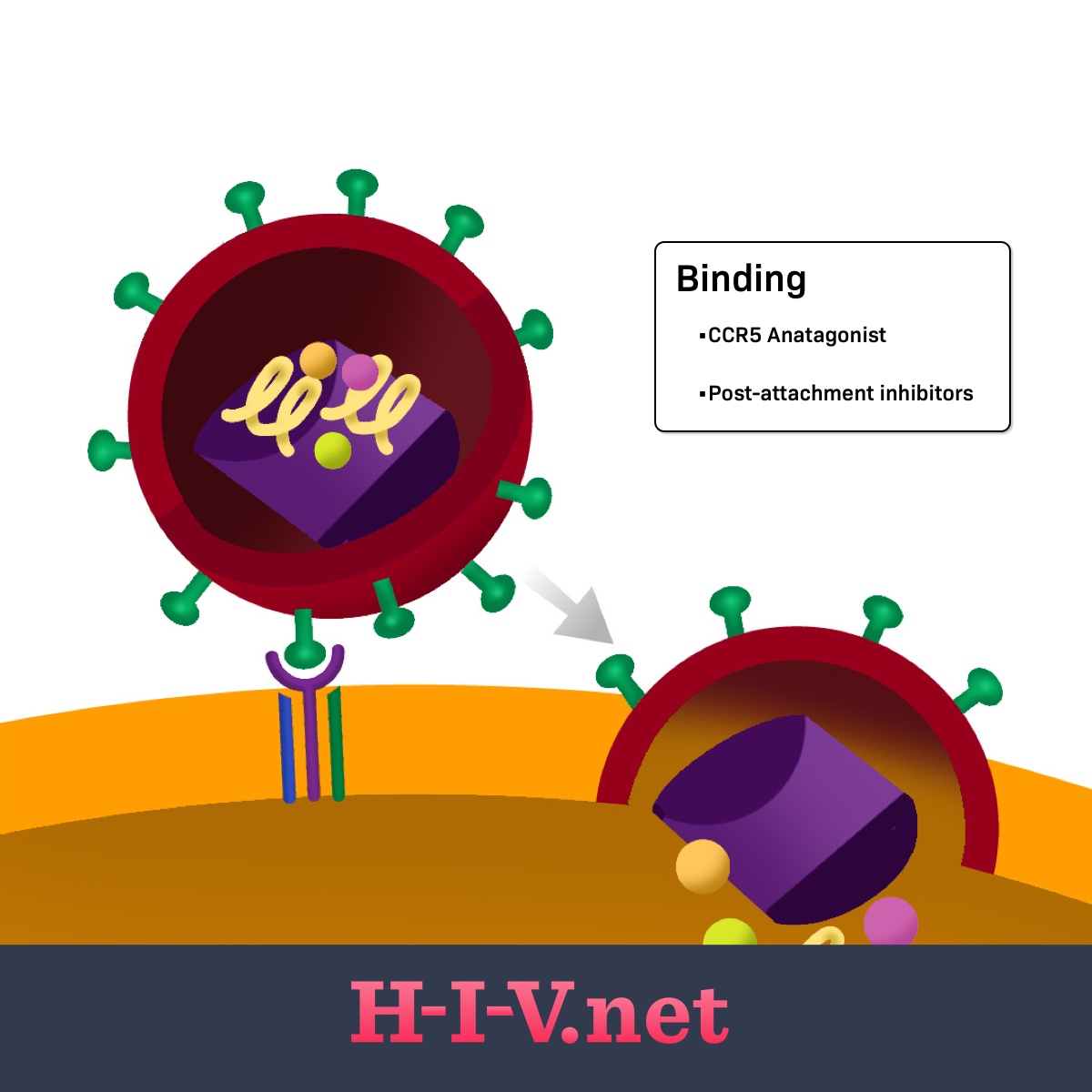CCR5 Antagonists
Reviewed by: HU Medical Review Board | Last reviewed: May 2025 | Last updated: May 2025
CCR5 antagonists are a class of drugs used to suppress HIV in the body. When CCR5 antagonists are used along with other HIV-fighting drugs, the treatment regimen is referred to as antiretroviral therapy (ART).1
HIV needs to enter human host cells, called CD4 cells or T cells, to replicate. To enter into these cells, HIV needs to bind to the host cell surface and then fuse with the host cell to get inside. CCR5 antagonists block the binding step in the process, preventing HIV from attaching and getting into its target cell to replicate.2
HIV life cycle
Viruses, like HIV, need human host cells to replicate. They cannot multiply on their own without human cells. When HIV particles called virions enter the body after a transmission event, the next main steps of the HIV lifecycle are as follows:1
- Binding
- Fusion
- Reverse transcription
- Integration
- Replication
- Assembly
- Budding
Figure 1. CCR5 antagonists target binding in the HIV life cycle
The HIV virions have proteins on the outside that recognize receptors on CD4 cells. Once a virion finds a CD4 cell, its outside proteins can bind to the CD4 cell receptor and link the CD4 cell and virion together (step 1: binding). For the virus to fully bind and fuse with the CD4 cell and get inside the cell to continue replication (step 2: fusion), other receptors on the CD4 cell surface may get involved. These additional receptors on the CD4 cell include the CCR5 or CXCR4 receptors. The HIV surface receptors involved in the first two steps are called gp120 and gp41. Any of these receptors on the CD4 cell or HIV itself may be targets for HIV drugs.2
Once inside the cell, the virion disassembles itself so it can begin the replication process. The next three steps represent the replication process of the virus’s genetic material. The last two steps of the process involve HIV reassembling itself into new, mature virions that can be released from the CD4 cell and enter the bloodstream, where they can go on to infect new cells.2
How do CCR5 antagonists work?
CCR5 antagonists block the CCR5 receptor on the outside of CD4 cells. CCR5 is involved in the binding of HIV to its target cell. HIV needs to bind using the CCR5 receptor in order to move on to the next step in the life cycle, fusion, and entry into the cell. When the CCR5 receptors are blocked by a CCR5 antagonist, HIV cannot adequately bind to its target cell. This stops the replication process since HIV needs to get inside the human host cells to replicate.2,3
Examples of CCR5 antagonists
There is one CCR5 antagonist drug approved to treat HIV:2,3
- Selzentry (maraviroc)
What are the possible side effects of CCR5 antagonists?
The most common side effects of Selzentry include:3
- Colds and cold-like symptoms
- Cough
- Fever
- Rash
- Bloating, gas, stomach upset
- Constipation
- Dizziness
Selzentry has a boxed warning, the strictest warning from the US Food and Drug Administration (FDA). It has this warning because it can cause serious side effects, including liver problems. Stop taking Selzentry and get medical help right away if you have any symptoms of liver problems, such as:3
- An itchy rash
- Your skin or the white part of your eyes turns yellow (jaundice)
- Dark urine
- Vomiting
- Pain, aching, or tenderness on the right side of your stomach
These are not all the possible side effects of Selzentry. Talk to your doctor about what to expect when taking Selzentry. You also should call your doctor if you have any changes that concern you when taking Selzentry.
Other things to know
Before starting treatment with a CCR5 antagonist, tell your doctor if you have:3
- Liver problems, including hepatitis B or C
- Heart problems
- Kidney problems
- Low blood pressure or taking medicines to lower your blood pressure
You should not take this drug while breastfeeding because of the risk of passing HIV to the baby. Before starting treatment with a CCR5 antagonist, tell your doctor if you are pregnant, planning to become pregnant, or breastfeeding.3
Before beginning treatment for HIV, tell your doctor about all your health conditions and any other drugs, vitamins, or supplements you are taking. This includes over-the-counter drugs.
